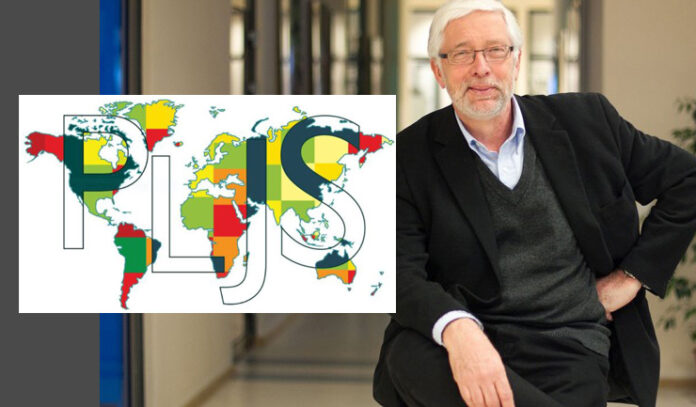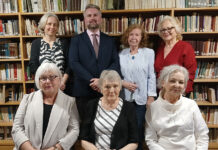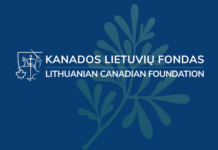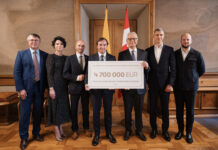
A well-known name in Canada and Lithuania, writer Antanas Šileika was the keynote speaker at the World Lithuanian Youth Congress which took place online at the end of June, 2021. He spoke in Lithuanian about his writing and its Lithuanian roots, the several phases of preserving Lithuanian identity in the diaspora, and how youth can best connect with Lithuania today. Tevzib.com is excited to present his speech for our readers, which he translated into English.
Thank you so much for this opportunity to address the World Lithuanian Youth Congress.
The last time I spoke in this context was around 1971 or 1972, so it’s great to be back with another talk around fifty years after my first one.
I was given two themes upon which to speak, both tradition creates the future, which sounds awkward in English, and modern Lithuanian identity. I have rephrased and fused these two ideas in the title above. Also, in this written translation, I have explained some points and expanded others I only mentioned in the original oral Lithuanian presentation.
Let me lay out the framework of these remarks. I will be speaking mostly about retaining current Lithuanian identity as one ages in the Lithuanian diaspora, which we used to call Lithuanian “exile” in my parents’ time.
Those of you who live in the Punsk region in Poland or nearby Belarus might find my words less appropriate to your situation because you are geographically close to Lithuania.
First, I will speak about the Lithuanian education and traditions taught to us in our childhood and youth. These are important, but insufficient for a sense of current Lithuanian identity, as I understand it.
Second, I’ll talk about a sort of break or turning point that comes upon diaspora Lithuanian young people in their twenties or thirties after they have grown up with those traditions.
Third, I’ll discuss what modern or current Lithuanian identity might mean and whether it is even necessary to maintain it.
First: Your generation and mine are vastly different. In my childhood, our centres of gravity were Lithuanian parishes, Saturday morning Lithuanian school attended by several hundred pupils, large groups of our parents and their Lithuanian friends, and a whole series of organizations whose goal was to have the children maintain their Lithuanian identity and help Lithuania to regain its independence.
In your generation, independence is no longer an issue.
Many of you probably speak Lithuanian better than I do because you completed some or all your education in Lithuania itself. I’ll return to the question of language a little later.
Still, we probably have certain childhood Lithuanian experiences in common.
Whether you come from large or tiny Lithuanian communities scattered across the world, your ideas about Lithuanian traditions and your understanding of Lithuanian identity probably came from the similar places:
– The stories of your parents or grandparents
– Folk dance groups
– Choirs
– Lithuanian schools of one kind or another, often informal
– Lithuanian cuisine
– Festival days such as kūčios or others
The other important element for building Lithuania identity a bit later in life, sometimes the most important element if you had enough other Lithuanians around, may have been friendships with Lithuanian peers that lasted beyond childhood right into late youth.
Friendships with local Lithuanians have continued to be my strongest links to local Lithuanian identity. I am writing and expanding the English version of this talk at Wasaga Beach, an old vacation spot for Toronto Lithuanians, and here I have a nodding relationship and sometimes much more with something approaching a hundred Lithuanian friends from my childhood. These types of relationships have become rare on the streets in Toronto because the Lithuanians fanned out into the suburbs over the past decades, so there is not much of a Lithuanian neighbourhood anymore. Here in Wasaga, I run into more recent immigrants from Lithuania as well.
After childhood, when I was a youth, the strongest attraction to Lithuanian identity was the access it gave me to Lithuanian girls. Canadian parents tended to be very protective of their daughters, but Lithuanian parents welcomed Lithuanian boys like me. I could hold Lithuanian girls’ hands and put my arms around them as a shy youth in folk dance ensembles, or later, have the chance to be a little more intimate with Lithuanian young women at summer camps or Lithuanian student conventions.
Second: Childhood and early youth end. We all grow up. And that’s when we reach a turning point in our relationship with our Lithuanian roots.
We might pair up with another Lithuanian like us, although that is statistically far from certain. And even if we do, our studies and youthful explorations end and we set out to create our professional adult futures.
If we marry outside the Lithuania diaspora circle, our partners might get tired of hearing, once again, about Lithuania. Therefore, it becomes easy to abandon interest in Lithuanian identity and activity in Lithuanian events.
Also, since we have grown far less religious as a culture, the old community centres of Lithuanian parishes hold less magnetic attraction and indeed the number of diaspora parishes is dwindling.
So we drift away, unless, of course, we have children and choose to re-enter with them the cycle of Lithuanian education and folk dancing.
I happened to marry within the Lithuanian diaspora, but a turning point occurred for me as well. I had been very active in the North American Lithuanian Student Union, once helping to organize a convention of 750 Lithuanian students and their supporters in Toronto in 1974.
But I became sick and tired of it all. A grown man is no longer interested in folk dancing, Vytautas Didysis, and cepelinai. I became profoundly bored of traditional Lithuanian activities that bordered on kitsch.
I tried to flee from Lithuanians. Living in Paris with my wife, we avoided Lithuanians and tried to blend into local life there.
But late one evening, someone knocked on my closed and locked shutters where I was living on the Rue de Javel, in a grittier part of the fifteenth arrondissement of Paris. My room was on the ground floor, and someone was standing outside there in the dark, trying to get my attention.
It turned out to be a Lithuanian young woman, the friend of a friend, who came to invite Snaige and me to come join the Lithuanians in Paris. These included several people our age, most of whom no longer spoke the language, and remnants of long-ago Lithuania, people like Colonel Lanskoronskis, who had walked out of Lithuania with Antanas Smetona, many nuns, and the storied Bačkis and Klimas families.
My break from the Lithuanians was real, and profound, and it took a lot more to get me involved again besides a knock on the locked shutters one night.
Third: What was critical for me was the annual academic conference of Santara-Šviesa which was held in an old holiday resort not far from Chicago before it moved to Lithuania after independence.
The conference consisted of three days of lectures about Lithuanian literature, philosophy, history, politics, and generally about various professional and academic topics involving Lithuanians. The conference was informed by an attitude of small “l” liberalism, one I was not accustomed to. You did what you wanted there without the stultifying formalities and religious observances of my parents’ generation. Santara forced no obligation on anyone. It was fun in an adult sort of way. You could hang at the bar, go to a lecture, or swim at the pool. Most people did all the above.
In the American years of the Santara conference, I managed to listen to riveting talks by outstanding intellects like those of Vytautas Kavolis, Aleksandras Štromas, Iccihokas Meras, Rimvydas Šilbajoris, Ilona Maziliauskiene, Violeta Kelertas, Algis Mickunas, and many others. The conference also also attracted a wide variety of eccentrics and bohemians.
In the Lithuanian conferences, I have had the joy of hearing other bright lights: the late Leonidas Donskis, Gintautas Mažeika, Darius Kuolys, Tomas Venclova, Egidijus Aleksandravicius, Dalia Kuiziniene, Žydronė Kolevinskiene, Emilija Sakadolskiene, and many others, not just in the auditorium but informally, at the bar or walking in the park. It’s like summer camp for brainy adults.
At these conferences, nobody was talking about cold beet borscht or traditional Lithuanian wedding customs.
Since I am interested in literature and history, in the eighties and nineties I attended the American conferences as often as I could, and out of them grew my literary career when Vytautas Kavolis once said to me: “I hear you want to be a writer. So write something, and we’ll publish it in Metmenys.”
I went on to write novels in English, my strongest language, but my themes have been Lithuanian. Arguably, Vytautas Kavolis and the Santara conferences set me on my life’s course.
So as the decades have passed, not only have I stopped fleeing from Lithuanian subject matter, but I seem to be getting into it more and more. I live in Canada, but I am also a member of an advisory committee of the World Lithuanian Community to the Lithuanian parliament, so under normal circumstances, I travel there at least twice a year.
I want to stress I am considering ways to be involved in current Lithuanian identity while living in the diaspora, because the easiest way to maintain your Lithuanian identity is to live in Lithuania, and then you wouldn’t need to think about it at all.
This was my story, but yours will be different. Your tastes will be dissimilar from mine and I doubt many of you will be attracted to maintain your modern Lithuanian identity by attending the Santara conferences or browsing used book shops in Vilnius and Kaunas.
You’re going to have to find your own vital contact with contemporary Lithuania, and that can grow out of the things that naturally interest you anyway. They will be various:
Foodies: Beatos virtuve is a weekly television show that focuses on Lithuanian food and this Martha Stewart of Lithuania has her own cookbook.
Sports: I suppose this subject is self-explanatory
Arts: There are so many good art galleries in Vilnius, covering so many styles and eras. Many of them have online shows as well. Music, theatre, and film offer a variety of cultural experiences too. Too many! It’s hard to keep up.
Academia and the Professions: Lithuania has made great contributions in biotech and laser technology and whatever profession you may practise will have its Lithuanian equivalent.
Visits: One should try to visit Lithuania as often as possible because the country evolves, as all countries do, so being current means being around now as much as is feasible and affordable.
It’s good to follow what’s going on in Lithuania for that very reason.
I watch the nightly national Lithuanian news, Panorama, which can be done for free using LRT (Lietuvos radijas ir televizija) Mediateka, a site that archives TV shows for two weeks at a time. I prefer another method, TV Aidas, a paid site that gives me access to several Lithuanian and European television channels (on my computer). Some very good television shows on LRT include Nacionalaine Ekspedicija (river boat travel through historical Lithuanian lands), Istorijos detektyvai, and Begliai (about people who tried to escape the Gulag).
Lietuvos Radijas ir Televizija – Mediateka – programos iš Lietuvos ir žinios:
http://www.tvaidas.com
When we do go to Lithuania, we must not do so arrogantly. Shortly after independence, the country saw many, many diaspora Lithuanians, mostly from the USA, who kept telling the people in the country how they should be doing things. There were carpetbaggers among these know-it-alls as well.
By now, we needn’t go to Lithuania to teach the inhabitants how to do things. When it comes to identity, we learn from them. We may engage in local topics, of course, and this sort of engagement brings us closer to the culture.
As well, we need to recognize that the official language of Lithuania is Lithuanian, not English. It’s very tough for us to keep up the language in the diaspora, but we should do the best we can.
If we wish to be current, and contemporary, we need to be aware of current Lithuanian political themes and threats. I’ll name a few:
A) At this writing, Belarus is actively trying to destabilize Lithuania by flying in so-called refugees through Turkey and ferrying them to the Lithuanian border and telling them passage to Europe will be easy this way. Already, some of the Lithuanian counties have been overwhelmed because of the resources needed to house and feed these people. The expense of further stiffening up the border is very high too. And if we are talking about threats, Russia plays an ongoing history revision game, implying that whole swathes of Eastern Europe really belong within a Russian sphere of influence.
B) Lithuania is undergoing a whole new branding exercise which it is using to bring in more international partners in the spheres of culture, business, sports and others. According to this branding strategy, we don’t talk about cepelinai, Jogaila, and countryside traditions, but try to seem modern and innovative. We talk about Lithuanian success in at the Venice Art Biennale, about the use of the country as location for shooting films such as Chernobyl. We no longer say we are Eastern European, and are near countries such as Poland, but say we are Northern European, not far from Sweden, because the latter description feels more powerful. The whole package is fascinating and perhaps a bit contentious because it glosses over some of history’s uglier chapters, but it is energetic and forward-looking.
Lietuvos įvaizdžio grupė: https://www.lrvalstybe.lt/kontaktai/lietuvos-ivaizdzio-grupe
C) Lithuania is sometimes attacked for its understanding of itself in the context of history. We should be aware of these controversies. Were the partisans heroes or bandits? Was the June uprising against the fleeing Soviets a proud national moment or an expression of underlying anti-Semitism? There was recently a conference hosted by The Lithuanian Historical Institute called Divisive Past, which examined how differently various groups regarded WW2 – be they Jews, Lithuanian, Poles, Ukrainians or others.
Lietuvos istorijos instituto konferencija apie istorija ir Holokaustą Lietuvoje:
„A Divisive Past“
https://www.facebook.com/watch/live/?v=119213156961377&ref=watch_permalink
There are many sharp differences of opinion about history in Lithuania, such as the question of what to do with the Statue of Petras Civirka in Vilnius. Was he merely a collaborator and traitor, or was he a great writer who should be remembered?
Author Silvia Foti takes a strong stand against her own grandfather, in The Nazi’s Granddaughter.
Controversies such as these are various and deal with the ongoing evolution of historical memory.
D) There are sensitive subjects in Lithuanian political life. The current government tried to introduce a bill on civil partnership last spring, but did not have enough votes to carry the motion. This sort of law would protect the rights of unmarried couples as well as same-sex couples, although it is does not open the door to gay marriage (The Lithuanian constitution states that a family consists of a man and a woman and thus gay marriage is constitutionally impossible in Lithuania unless through an amendment, which is highly unlikely any time in the foreseeable future).
I am a big supporter of gay rights because one of my family is gay and elemental rights for gay people have been standard in the west for quite some time. However, there is a strong anti-gay stream in the Lithuanian electorate. A contentious march to support family rights was organized in Lithuania, and I read this as code for what was really an anti-gay march. To my distress, the president supported this march and its participants even though some of them were shown by investigative journalists to have ties to dubious populist organizations. I’ll include a link to the LRT investigation of this event.
Šeimos maršas
Partnerystės byla:
E) Lithuania is undergoing a serious demographic problem. We, the diaspora, are part of this problem. Lithuania supports itself through taxes, and the lower the number of inhabitants, the lower national wealth falls. Some would argue that to be supportive, one should live in Lithuania. Yet so many of us have made our lives abroad.
We in the diaspora often would like more input from Lithuania itself, whether about education materials for Lithuanian schools, or the right to preserving Lithuanian citizenship when taking on the citizenship of another country. It is fine to want things, but we should also be willing to give as well. Let me rephrase what the late President Kennedy once said: “Let’s not ask what Lithuania can give us, but what we can give to Lithuania.”
Contemporary ties with Lithuania cannot be static because time does not stand still. Since the times do change, our ties with Lithuania need to evolve if we want them to be ties to current Lithuania.
We can certainly live with traditions and sentiments, doing things like celebration Kucios or making saltibarsciai. Traditions are important, after all, because our feelings about them are real. They are important and necessary, but we don’t live our current lives based on sentiments alone.
True contemporary life is dynamic, lively, and adaptable, and so should be our ties with modern Lithuania.
Obviously, what I am saying is only true if we wish to maintain current ties. Not everyone will find them important. And that is fine. There is no moral obligation to maintain current ties. There is only desire and the various routes to its fulfillment. As in all other aspects of life, some people want more and some people want less. Some are motivated by history and some our interested by current trends.
But if I return to my assigned topic, namely current Lithuanian identity, such an identity must have ties to current Lithuania.



























